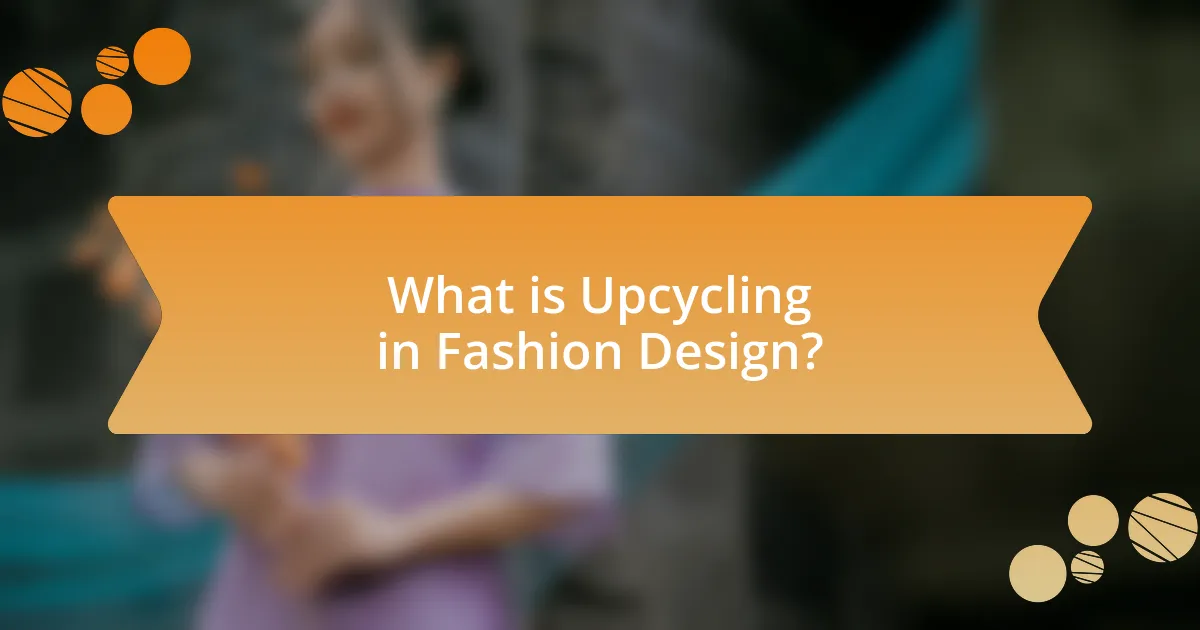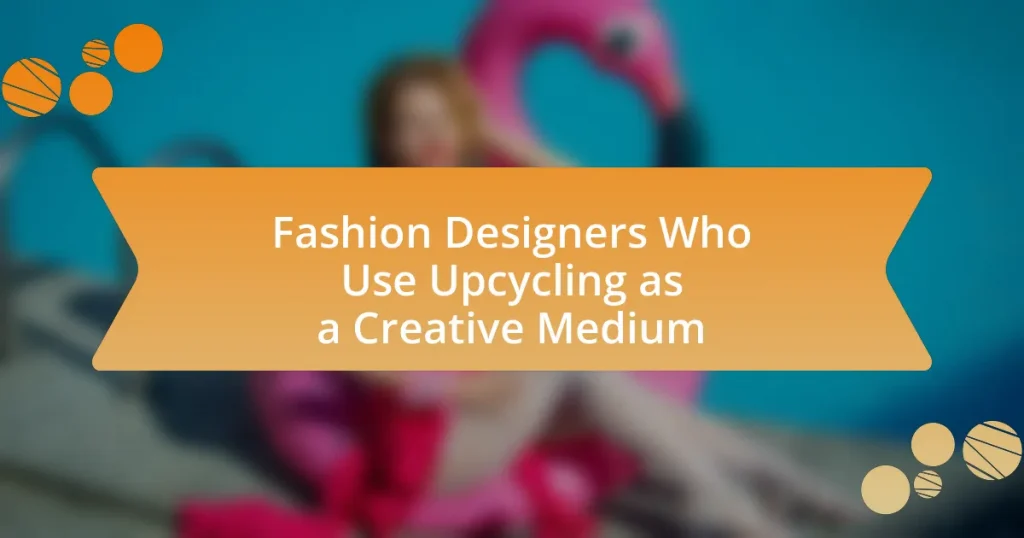The article focuses on fashion designers who utilize upcycling as a creative medium, highlighting the process of transforming waste materials into new, higher-quality fashion items. It distinguishes upcycling from traditional fashion design by emphasizing the repurposing of existing materials to reduce textile waste and promote sustainability. Key designers such as Stella McCartney and Vivienne Westwood are discussed for their innovative approaches, along with the environmental benefits of upcycling, including waste reduction and resource conservation. The article also addresses the challenges designers face in sourcing materials and maintaining design integrity while educating consumers about the value of upcycled fashion.

What is Upcycling in Fashion Design?
Upcycling in fashion design refers to the process of transforming waste materials or unwanted products into new, higher-quality items. This practice not only reduces textile waste but also promotes sustainability by encouraging the reuse of materials that would otherwise contribute to environmental pollution. For instance, designers like Stella McCartney and Vivienne Westwood have successfully incorporated upcycling into their collections, demonstrating its viability as a creative medium in the fashion industry.
How does upcycling differ from traditional fashion design?
Upcycling differs from traditional fashion design primarily in its focus on repurposing existing materials rather than creating new textiles. Upcycling involves transforming discarded items into new fashion pieces, which reduces waste and promotes sustainability. In contrast, traditional fashion design typically relies on new fabrics and materials, contributing to resource consumption and environmental impact. For example, a study by the Ellen MacArthur Foundation highlights that the fashion industry is responsible for 92 million tons of waste annually, emphasizing the need for sustainable practices like upcycling to mitigate this issue.
What materials are commonly used in upcycling?
Common materials used in upcycling include textiles, wood, glass, metal, and plastic. Textiles often come from discarded clothing or fabric scraps, allowing designers to create new garments or accessories while reducing waste. Wood can be sourced from old furniture or pallets, which can be transformed into unique home decor or functional items. Glass is frequently repurposed from bottles or jars, often turned into art pieces or functional containers. Metal, such as cans or scrap metal, is utilized for creating jewelry or sculptures. Lastly, plastic materials, including bags or containers, are often reimagined into new products, contributing to a circular economy. These materials are favored for their availability and versatility in creative projects.
How does the process of upcycling work in fashion?
Upcycling in fashion involves transforming discarded materials or garments into new, higher-value products. This process typically begins with the collection of unwanted textiles, which are then creatively reimagined through techniques such as sewing, dyeing, or embellishing. Designers like Stella McCartney and Reformation exemplify this practice by using surplus fabrics and vintage clothing to create unique collections, thereby reducing waste and promoting sustainability. The effectiveness of upcycling is supported by the fact that it can significantly lower the environmental impact of fashion production, as it utilizes existing resources rather than relying on new materials.
Why is upcycling important in the fashion industry?
Upcycling is important in the fashion industry because it reduces waste and promotes sustainability. The fashion industry is one of the largest polluters globally, with an estimated 92 million tons of textile waste generated annually. By transforming discarded materials into new products, upcycling minimizes the environmental impact and conserves resources. Additionally, upcycling fosters creativity among designers, allowing them to create unique pieces that stand out in a saturated market. This practice not only addresses ecological concerns but also aligns with the growing consumer demand for sustainable and ethically produced fashion.
What environmental benefits does upcycling provide?
Upcycling provides significant environmental benefits by reducing waste and conserving resources. By transforming discarded materials into new products, upcycling diverts waste from landfills, thereby decreasing the volume of waste generated. According to the Environmental Protection Agency, in 2018, approximately 292.4 million tons of municipal solid waste were generated in the United States, with textiles contributing a substantial portion. Upcycling also minimizes the need for new raw materials, which reduces energy consumption and lowers carbon emissions associated with manufacturing processes. For instance, producing recycled polyester from plastic bottles uses up to 75% less energy compared to creating virgin polyester. Thus, upcycling not only mitigates waste but also promotes resource efficiency and sustainability.
How does upcycling contribute to sustainability in fashion?
Upcycling contributes to sustainability in fashion by transforming waste materials into new products, thereby reducing the demand for new resources and minimizing environmental impact. This practice helps divert textiles from landfills, where they would otherwise contribute to pollution and greenhouse gas emissions. For instance, according to the Ellen MacArthur Foundation, the fashion industry is responsible for 10% of global carbon emissions, and upcycling can significantly mitigate this by extending the lifecycle of existing materials. By creatively reusing fabrics and garments, designers not only promote resource efficiency but also foster a circular economy, which is essential for sustainable development in the fashion sector.

Who are Notable Fashion Designers Using Upcycling?
Notable fashion designers using upcycling include Stella McCartney, who is renowned for her commitment to sustainable fashion and utilizes recycled materials in her collections. Another prominent designer is Christopher Raeburn, known for his innovative approach to repurposing military surplus and other materials into high-fashion garments. Additionally, Vivienne Westwood incorporates upcycled elements into her designs, emphasizing environmental consciousness. These designers exemplify the integration of upcycling into contemporary fashion, showcasing how sustainability can be a creative medium.
What are some prominent examples of designers who focus on upcycling?
Prominent examples of designers who focus on upcycling include Stella McCartney, who is known for her commitment to sustainable fashion and uses recycled materials in her collections. Another notable designer is Christopher Raeburn, who specializes in creating garments from surplus materials and military fabrics, emphasizing the importance of reducing waste. Additionally, the brand Re/Done, founded by Sean Barron and Jamie Mazur, upcycles vintage denim into modern styles, showcasing the potential of reimagining existing materials. These designers exemplify the innovative approach to sustainability in fashion through their upcycling practices.
What unique techniques do these designers employ in their work?
Fashion designers who use upcycling as a creative medium employ techniques such as deconstruction, patchwork, and innovative textile manipulation. Deconstruction involves taking apart existing garments to create new forms and silhouettes, allowing for a fresh interpretation of materials. Patchwork combines various fabric scraps into cohesive designs, showcasing creativity and sustainability. Innovative textile manipulation includes techniques like dyeing, printing, and embellishing to transform discarded materials into high-fashion pieces. These methods not only reduce waste but also challenge traditional fashion norms, promoting a more sustainable approach to design.
How do these designers source their materials for upcycling?
Designers who focus on upcycling source their materials primarily from discarded textiles, vintage clothing, and surplus fabric. They often collaborate with local thrift stores, textile recycling centers, and community donation programs to obtain these materials. For instance, a study by the Ellen MacArthur Foundation highlights that upcycling can significantly reduce waste by repurposing materials that would otherwise end up in landfills. This approach not only promotes sustainability but also encourages creativity in fashion design by transforming existing items into new, unique pieces.
What impact do these designers have on the fashion industry?
Designers who use upcycling as a creative medium significantly influence the fashion industry by promoting sustainability and reducing waste. Their innovative approaches challenge traditional manufacturing processes and encourage consumers to rethink their purchasing habits. For instance, brands like Reformation and Stella McCartney have successfully integrated upcycled materials into their collections, demonstrating that eco-friendly practices can coexist with high fashion. This shift not only attracts environmentally conscious consumers but also pressures other brands to adopt sustainable practices, thereby transforming industry standards.
How do they influence consumer behavior towards sustainable fashion?
Fashion designers who use upcycling as a creative medium influence consumer behavior towards sustainable fashion by promoting the value of repurposed materials and environmentally conscious practices. These designers showcase innovative designs that transform waste into desirable fashion items, thereby encouraging consumers to appreciate sustainability and make more eco-friendly purchasing decisions. For instance, brands like Re/Done and Eileen Fisher have successfully integrated upcycled materials into their collections, leading to increased consumer awareness and demand for sustainable options. This shift is supported by research indicating that 66% of global consumers are willing to pay more for sustainable brands, highlighting the impact of upcycling designers on consumer preferences.
What trends have emerged from their upcycling practices?
Trends that have emerged from upcycling practices among fashion designers include the increased use of sustainable materials, the rise of personalized and unique fashion items, and a focus on circular economy principles. Designers are increasingly sourcing discarded textiles and materials to create new garments, which reduces waste and promotes environmental sustainability. For instance, brands like Reformation and Stella McCartney have successfully integrated upcycled materials into their collections, demonstrating a commitment to eco-friendly practices. Additionally, the trend towards personalized fashion has led to one-of-a-kind pieces that cater to individual consumer preferences, further enhancing the appeal of upcycled fashion. This shift not only addresses environmental concerns but also aligns with consumer demand for authenticity and uniqueness in their clothing choices.

What Challenges Do Fashion Designers Face with Upcycling?
Fashion designers face several challenges with upcycling, including sourcing quality materials, maintaining design integrity, and consumer perception. Sourcing quality materials can be difficult as designers often rely on discarded textiles that may vary in condition and availability, impacting the overall quality of the final product. Maintaining design integrity is another challenge, as designers must creatively transform existing garments while ensuring that the new designs are aesthetically appealing and functional. Additionally, consumer perception poses a challenge; some consumers may view upcycled fashion as inferior or less desirable compared to new garments, which can affect market demand. These challenges highlight the complexities involved in integrating upcycling into mainstream fashion design.
What are the common obstacles in sourcing materials for upcycling?
Common obstacles in sourcing materials for upcycling include limited availability, inconsistent quality, and logistical challenges. Limited availability arises because upcycled materials often depend on local waste streams, which can vary significantly by region and season. Inconsistent quality is a concern as the condition of discarded items can differ widely, affecting their suitability for new designs. Logistical challenges involve the difficulty of collecting, transporting, and storing materials, which can hinder the efficiency of the upcycling process. These factors collectively complicate the efforts of fashion designers who aim to creatively repurpose materials.
How do designers overcome these sourcing challenges?
Designers overcome sourcing challenges by establishing strong relationships with suppliers and utilizing innovative materials. By collaborating with local artisans and manufacturers, designers can access unique resources that align with their creative vision while also supporting sustainable practices. For instance, many designers source surplus fabrics from textile mills or second-hand materials from thrift stores, which not only reduces waste but also provides a diverse palette for their designs. This approach is supported by the growing trend of circular fashion, which emphasizes the importance of reusing materials to minimize environmental impact.
What limitations exist in the design process of upcycled fashion?
The design process of upcycled fashion faces several limitations, primarily related to material availability and quality. Designers often rely on discarded textiles, which can vary significantly in condition, color, and texture, making it challenging to create cohesive and high-quality garments. Additionally, the unpredictability of sourcing materials can restrict creative possibilities, as designers may not find enough suitable fabric to execute their vision. Furthermore, there are technical constraints, such as the need for specialized skills to work with unconventional materials, which can limit the pool of designers capable of producing upcycled fashion. These factors collectively hinder the scalability and mainstream adoption of upcycled fashion within the industry.
How do designers balance creativity and sustainability in upcycling?
Designers balance creativity and sustainability in upcycling by integrating innovative design techniques with eco-friendly practices. They utilize discarded materials to create unique fashion pieces, ensuring that the creative process does not compromise environmental responsibility. For instance, brands like Reformation and Eileen Fisher focus on sourcing surplus textiles and transforming them into stylish garments, thereby reducing waste and promoting circular fashion. This approach not only fosters creativity through the challenge of working with limited resources but also aligns with sustainability goals by minimizing the carbon footprint associated with new material production.
What strategies do they use to maintain artistic integrity while being eco-friendly?
Fashion designers who use upcycling as a creative medium maintain artistic integrity while being eco-friendly by integrating sustainable materials and innovative design techniques. They often source discarded textiles and materials, transforming them into unique pieces that reflect their artistic vision. For instance, designers like Stella McCartney prioritize organic fabrics and ethical production methods, ensuring that their creations align with both environmental standards and their artistic goals. This approach not only reduces waste but also fosters a distinct aesthetic that resonates with eco-conscious consumers, demonstrating that sustainability and creativity can coexist effectively.
How do they educate consumers about the value of upcycled fashion?
Fashion designers who use upcycling as a creative medium educate consumers about the value of upcycled fashion through various strategies, including storytelling, workshops, and social media campaigns. These designers often share the narratives behind their creations, highlighting the environmental benefits of reducing waste and the unique qualities of upcycled materials. For instance, brands like Reformation and Patagonia emphasize sustainability in their marketing, showcasing statistics that illustrate the reduction of carbon footprints and resource conservation achieved through upcycling. Additionally, workshops and events allow consumers to engage directly with the process, fostering a deeper understanding of the craftsmanship involved and the positive impact on the environment.
What are some best practices for aspiring designers interested in upcycling?
Aspiring designers interested in upcycling should prioritize sourcing materials sustainably, focusing on second-hand or discarded items to minimize waste. This practice not only reduces environmental impact but also encourages creativity by challenging designers to reimagine existing materials. Additionally, they should develop skills in sewing and textile manipulation, as these techniques are essential for transforming old garments into new designs. Engaging with the upcycling community through workshops and online platforms can provide valuable insights and inspiration, fostering collaboration and innovation. Research indicates that the global fashion industry generates over 92 million tons of waste annually, highlighting the importance of upcycling as a viable solution to reduce this figure and promote sustainable practices.
How can new designers effectively start their upcycling journey?
New designers can effectively start their upcycling journey by identifying materials that can be repurposed, such as discarded clothing or fabric scraps. This approach allows designers to creatively transform waste into unique fashion pieces, promoting sustainability. Research indicates that the global fashion industry generates over 92 million tons of waste annually, highlighting the importance of upcycling as a solution to reduce this environmental impact. By sourcing materials locally and experimenting with different techniques, new designers can develop their skills while contributing to a more sustainable fashion ecosystem.
What resources are available for learning about upcycling in fashion?
Resources for learning about upcycling in fashion include online courses, books, and community workshops. Online platforms like Coursera and Skillshare offer courses specifically focused on sustainable fashion and upcycling techniques. Books such as “The Upcycle: Beyond Sustainability—Designing for Abundance” by William McDonough and Michael Braungart provide in-depth insights into the philosophy and practice of upcycling. Additionally, local community centers and fashion schools often host workshops that teach practical skills for upcycling clothing and materials, fostering hands-on learning experiences.



